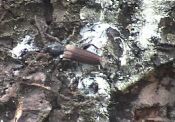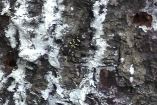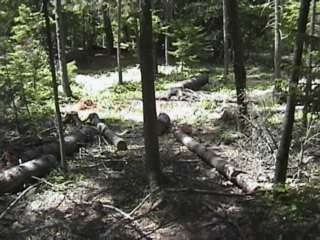
Tetropium fuscum.

Christopher Majka Whenever I return from overseas I always know when I've reached Canada. Flying across Europe I look down on fields bordered by roads, lanes and hedgerows. Then follow several hours of sparkling blue ocean. When an unending expanse of forests below I know I'm back.
Raised on a continent where extensive tracts of forests have long since disappeared, Europeans are accustomed to treating forests and trees as a precious resource. Foresters, naturalists, and the public at large as all having a legitimate role and voice in their use and conservation. In Canada both private and public owners have for far too long treated forests contemptuously, neglecting forest maintenance, overcutting, spraying insecticides and herbicides, and cultivating mon-culture plantations designed for rapid growth, pulping, and then exported as newsprint or toilet paper.
 |
| The Brown Spruce Longhorn Beetle Tetropium fuscum. |
A telling illustration of this silvicultural legacy has been the obviously worsening health of the trees in Point Pleasant Park, once an emerald at the tip of the Halifax Peninsula. Instead of examining the reasons why the Park's trees are ailing and conducting an environmental review process that would have allowed the public to voice concerns and raise questions, the Canadian Food Inspection Agency (CFIA) - the government agency responsible for agricultural and food regulation in Canada - announced it was going to incinerate 10,000 mature spruce trees in the Park this year and possibly more in successive years. The professed grounds for this drastic action: the Park harbours the Brown Spruce Longhorn (BSL) Beetle [Tetropium fuscum] an insect from Europe alleged to threaten the whole North American softwood forest industry. Its presence in the Park had been noted in connection with ailing trees there and the CFIA apparently jumped to the conclusion that this insect must be responsible.
At the same time the CFIA launched a media campaign that claimed inter alia that the Park was infested by millions of BSL Beetles, there were no predators for this imported pest, that the BSL Beetle was attacking and killing healthy trees and was invading species other than Red Spruce, that immediate cutting and burning possibly infected trees was the only way of dealing with this pest, and that the BSL Beetle has spread beyond the Park. In fact, only the last of these claims appears to be backed by any substantive evidence at all.
 |
| Xylotrechus undulatus: another common longhorn beetle in Point Pleasant Park. |
When the BSL Beetle first arrived in Halifax from Europe is unknown given that Halifax has been a port for 350 years. When it was first collected in a 1990 study of the Park's beetles, it was initially misidentified. At that time only 17 adult BSL Beetles were found. In 1999, trapping in the Park found none; this past summer, despite extensive searching, the CFIA and other agencies were apparently able to trap hardly any at all. So much for an infestation! In fact, this European beetle is only a minor component of a spectrum of forest insects in Point Pleasant Park that feed on sick and dying spruce. At least four other longhorn beetles, three metallic wood-boring beetles, several species of horntails (wood-boring wasps) and more than 20 species of bark-boring beetles (all native insects) are found in the Park and contribute to the symptoms seen on spruce trees there. A robust community of BSL Beetle predators can also readily be observed in the Park, including four species of abundant checkered beetles and several species of wasps.
Studies by European entomologists all conclude that the BSL Beetle, which is widely distributed throughout northern Europe, is an insect that feeds on ill and dying trees and doesn't threaten healthy forests. To hold it responsible for the ill health of trees in the Park is to confuse cause and effect.
 |
| Trees being cut in Point Pleasant Park |
A citizen's group, Friends of Point Pleasant Park, has secured a temporary injunction to halt the CFIA's logging operation in the Park. What is at stake is one of the most important civic parks in the country receiving over 1.4 million visits annually. It is a major tourist attraction, and an important natural, historic, and recreational resource.
The "beetle battle" remains unresolved at this time. But two lessons are already clear: First, that the public is increasingly unwilling to accept arbitrary imposition by government agencies of decisions that are unsupported by adequate scientific evidence. Second, that our environmental attitudes must change. We cannot continue to regard our coniferous forests solely as future pulp and lumber to accommodate the interests of the forest paper and construction industries, while sacrificing other legitimate values and concerns. If the Park and our forests generally are to be restored to better environmental health, we need more sophistication in understanding them as complex, living ecosystems valued by naturalists, hikers, cyclists, native peoples, and foresters. Perhaps we should fear European imports less, and learn from European experience more!
Neuschottländer Bote
Winter, 2000/01
[Home] [Press Releases] [History] [Get Involved] [Photo Gallery] [Links]